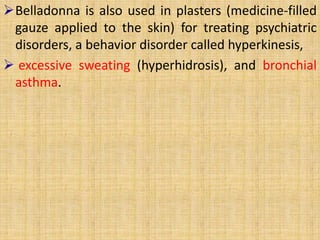Belladonna
- 2. SUBJECT:PHARMACOGNOCY TOPIC: BALLADONNA HERB SUBMITTED TO: GOWRI SHANKAR SIR PRESENTED BY: SHAIK MOWLALI
- 3. SYNONYMS:Belladonna leaf, Belladonna herb. BIOLOGICAL SOURCE: It consists of dried leaves and other aerial parts of atropa belladonna Linn. FAMILY: solanaceae GEOGRAPHICAL SOURCE: England, Europe. In india, it is found in the western himalayas from simla to kasmir & adjoining areas of Himachal pradesh.
- 8. Cultivation of belladonna at an altitude of 1400 m from sea level is found to be satisfactory. Belladonna berries are curshed to get the seeds for cultivation. Proper processing like washing and sieving is performed. Only healthy seeds are used for cultivation. Seeds are sown by broadcasting method in well prepared beds with the application of fungicide like diathon. Sowing is done in may & july
- 9. The seedlings are ready for transplantation by the end of September. Transplanting is done by keeping certain distance between two plants & the seedlings are irrigated carefully. Fertilizers like urea, potash & superphosphate are given as per the needs. Insecticidal sprays like sevin are also tried when the plant reaches maturity. The leaves,as well as, the flowering tops are cut & sundried (or)dried in shade.
- 10. During drying, care is taken to retain the green colour. While grading and packing for market, woolly stems and foreign organic matter are rejected. The yield per hectare is found to be 200 to 600kg
- 11. Colour: Leaves are greenish brown. Odour: Slight & characteristic. Taste: Bitter.
- 12. Dorsiventral leaf Collenchyma above & below the mid rib Unicellular covering trichomes, unicellular glandular trichomes Microsphaenoidal calcium oxalate crystals
- 14. The total alkaloidal content of drug is 0.4 to 1% & varies in different parts of plant roots (0.6), stems (0.05%), leaves (0.4%), unripe & ripe berries (0.19-0.21%) & seeds (0.33%). The main alkaloids are l-hyoscyamine & its racemic form atropine. The drug also contains belladonine, scopoletin, hyoscine, pyridine & N-methyl pyrroline. The later two are the volatile bases.
- 16. Belladonna is used as a sedative, to stop bronchial spasms in asthma and whooping cough, and as a cold and hay fever remedy. It is also used for Parkinson's disease, (is a brain disorder that causes a gradual loss of muscle control.)colic, motion sickness, and as a painkiller. Belladonna is used in ointments that are applied to the skin for joint pain (rheumatism), leg pain caused by a disc in the backbone pushing on the sciatic nerve (sciatica), and nerve pain (neuralgia).
- 17. Belladonna is also used in plasters (medicine-filled gauze applied to the skin) for treating psychiatric disorders, a behavior disorder called hyperkinesis, excessive sweating (hyperhidrosis), and bronchial asthma.


















